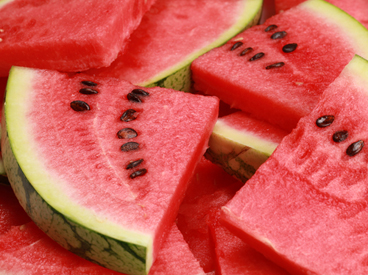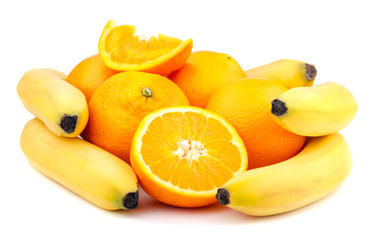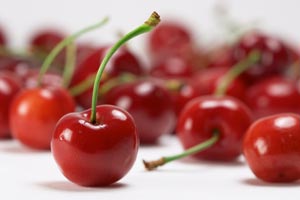Spring Recipes from The Green Smoothie Bible
“What you find in season at the spring market will vary based on where you live,”says Kristine Miles, author of The Green Smoothie Bible. “In more moderate climates, such as where I live in Southern Australia, many of these fruits will be readily available, while others may be very hard to find. Use this opportunity to experiment with what is fresh to create your own green smoothies.”

Recipe 1
- 1 cup cranberries
- 1 orange, peeled
- Zest of ½ orange
- 1 ½ cups orange juice
- Greens

Recipe 2
- 2 ½ cups watermelon
- 1 cup raspberries
- 1 lime, peeled
- Greens
 Tip: If you’re new to green smoothies, Miles recommends that only 10 percent of your smoothie be greens (spinach is a good beginner’s green because of its mild flavor) and gradually increase them to 40 percent as you grow accustomed to the taste.
Tip: If you’re new to green smoothies, Miles recommends that only 10 percent of your smoothie be greens (spinach is a good beginner’s green because of its mild flavor) and gradually increase them to 40 percent as you grow accustomed to the taste.
Looking for more? The Post has featured nine of the 300 recipes available in The Green Smoothie Bible (three summer smoothies, two autumn smoothies, and two winter smoothies). Try one or all and share your green smoothie adventures in the comments below.
Winter Recipes from The Green Smoothie Bible
“Winter produce can certainly present a challenge compared with the abundance of summer fruits. But it also can be a time for creativity when it comes to green smoothies,” says Kristine Miles, author of The Green Smoothie Bible. “Ginger and warming spices like cinnamon can be used. Nut milks, ginger, and spices can add a more filling and warming element to a winter green smoothie. By the same token, use of ice and frozen fruit is best avoided given the weather is cold enough as it is!”
Recipe 1
- 1 cup pineapple with core
- ½ grapefruit
- ½ avocado
- 1½ cups water
- Greens (See tip below)
Recipe 2
- 4 oranges and/or tangelos, peeled
- 1 to 2 tablespoons chia seeds
- 1 cup fennel juice
- Fennel tops (See tip below)

Tip: If you’re new to green smoothies, Miles recommends that only 10 percent of your smoothie be greens (spinach is a good beginner’s green because of its mild flavor) and gradually increase them to 40 percent as you grow accustomed to the flavor.
Of the 300 available recipes in The Green Smoothie Bible, we will feature nine of Kristine Miles’ seasonal recipes (three more in summer, two in fall, and two in spring). Try one or all and share your green smoothie adventures in the comments below.
Autumn Recipes from The Green Smoothie Bible
“Autumn is my favorite time of the year, especially when there’s often a glut of end-of-season summer produce like strawberries and peaches, while new season fruits like apples and pears make a long-awaited return,” says Kristine Miles, author of The Green Smoothie Bible. Celebrate this colorful season with some of her delicious green smoothies below!
Recipe 1
- 2 kiwifruit
- ½ avocado
- 2 oranges, peeled
- 1 ½ cups water
- Mint (See tip below)
Recipe 2
- 2 bananas
- 4 passion fruit
- 1 orange, peeled
- 1 ½ cups water
- Greens (See tip below)
 Tip: If you’re new to green smoothies, Miles recommends that only 10 percent of your smoothie be greens (spinach is a good beginner’s green because of its mild flavor) and gradually increase them to 40 percent as you grow accustomed to the flavor.
Tip: If you’re new to green smoothies, Miles recommends that only 10 percent of your smoothie be greens (spinach is a good beginner’s green because of its mild flavor) and gradually increase them to 40 percent as you grow accustomed to the flavor.
Of the 300 available recipes in The Green Smoothie Bible, we will feature nine of Kristine Miles’ seasonal recipes (three in summer and two more in winter and two in spring). Try one or all and share your green smoothie adventures in the comments below.
Summer Recipes from The Green Smoothie Bible
 “Eat your greens!” and “Chew your food!” Two sentences often spoken by parents at the dinner table. In The Green Smoothie Bible
“Eat your greens!” and “Chew your food!” Two sentences often spoken by parents at the dinner table. In The Green Smoothie Bible, author Kristine Miles creates a hybrid from the two digestive phrases: Drink your greens!
Wait—what?
Drink spinach?
Well, yes—sort of. Miles does suggest starting a smoothie with spinach (it’s high in protein and mildly flavored—compared to other greens like watercress or kale). But don’t worry, she’s not proposing you toss back a glass of blended bok choy or mint leaves.
“A green smoothie is a fruit smoothie with raw leafy greens blended through it,” writes Miles.
Now you might be thinking, Why would anyone want to ruin a perfectly good smoothie with alfalfa sprouts?
Miles puts forth a pretty good argument: “Greens are rich in fiber, vitamins, minerals, antioxidants, pigments like chlorophyll and cartenoids, and even essential fatty acids such as omega-3s.”
Along with celebrating the virtue of these verdant plants, she includes tips on how to grow your own herbs, sprouts, and microgreens; describes the ideal blender; and provides a surprisingly objective view of the raw food diet. The second half of the book is filled with 300 recipes beginning with seasonal recipes and moving to blends for bone, heart, and digestive health, among others. She even offers smoothies that advertise mood and hormone regulation.
Of the 300 available recipes in The Green Smoothie Bible, we will be featuring nine of Kristine Miles’ seasonal recipes (three in summer and two in fall, winter, and spring). Try one or all, and share your green smoothie adventures in the comments below.
If you’re new to green smoothies, Miles recommends that only 10 percent of your smoothie be greens and gradually increase them to 40 percent as you grow accustomed to the flavor.
Recipe 1
- 3½ cups watermelon
- 1 inch fresh ginger
- 2 tablespoons chia seeds (optional, for a thicker smoothie)
- Greens*
Recipe 2
- 1 cup blueberries
- 1 large banana
- 1½ cups of nut milk or water
- Greens*
Recipe 3
- 1 cup pitted cherries
- 1 banana
- 1 to 2 tablespoons raw cacao
- 1½ cups water or nut milk
- Greens*







